check engine light Citroen C4 PICASSO 2009 1.G Owner's Manual
[x] Cancel search | Manufacturer: CITROEN, Model Year: 2009, Model line: C4 PICASSO, Model: Citroen C4 PICASSO 2009 1.GPages: 337, PDF Size: 12.91 MB
Page 19 of 337
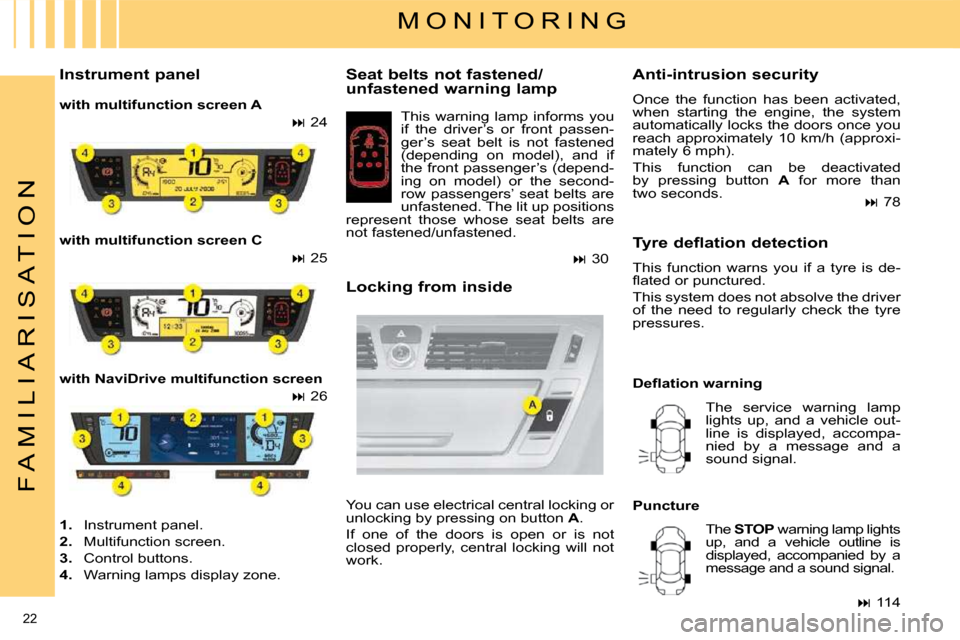
22
F A M I L I A R I S A T I O N
Seat belts not fastened/
unfastened warning lamp This warning lamp informs you
if the driver’s or front passen-
ger’s seat belt is not fastened
(depending on model), and if
the front passenger’s (depend-
ing on model) or the second-
row passengers’ seat belts are
unfastened. The lit up positions
represent those whose seat belts are
not fastened/unfastened.
You can use electrical central locking or
unlocking by pressing on button A .
If one of the doors is open or is not
closed properly, central locking will not
work. Tyre deflation detection
This function warns you if a tyre is de-
�fl� �a�t�e�d� �o�r� �p�u�n�c�t�u�r�e�d�.�
This system does not absolve the driver
of the need to regularly check the tyre
pressures.
The service warning lamp
lights up, and a vehicle out-
line is displayed, accompa-
nied by a message and a
sound signal.
� � �D�e�fl� �a�t�i�o�n� �w�a�r�n�i�n�g� �
The STOP warning lamp lights
up, and a vehicle outline is
displayed, accompanied by a
message and a sound signal.
Puncture
� 30
� 114
Anti-intrusion security
Once the function has been activated,
when starting the engine, the system
automatically locks the doors once you
reach approximately 10 km/h (approxi-
mately 6 mph).
This function can be deactivated
by pressing button
A for more than
two seconds.
� 78
M O N I T O R I N G
Locking from inside
Instrument panel
with multifunction screen A
� 24
with multifunction screen C
� 25
with NaviDrive multifunction screen
� 26
1. Instrument panel.
2. Multifunction screen.
3. Control buttons.
4. Warning lamps display zone.
Page 21 of 337
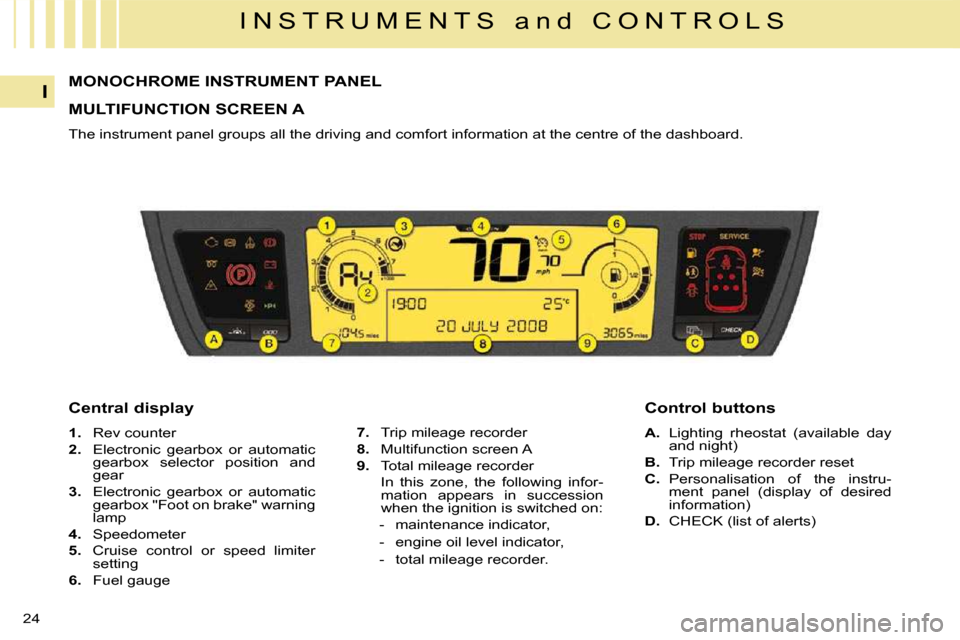
24
I
I N S T R U M E N T S a n d C O N T R O L S
MONOCHROME INSTRUMENT PANEL
MULTIFUNCTION SCREEN A
The instrument panel groups all the driving and comfort information at the centre of the dashboard.
Central display
1. Rev counter
2. Electronic gearbox or automatic
gearbox selector position and
gear
3. Electronic gearbox or automatic
gearbox "Foot on brake" warning
lamp
4. Speedometer
5. Cruise control or speed limiter
setting
6. Fuel gauge
7. Trip mileage recorder
8. Multifunction screen A
9. Total mileage recorder
In this zone, the following infor- mation appears in succession
when the ignition is switched on:
- maintenance indicator,
- engine oil level indicator,
- total mileage recorder. Control buttons
A. Lighting rheostat (available day
and night)
B. Trip mileage recorder reset
C. Personalisation of the instru-
ment panel (display of desired
information)
D. CHECK (list of alerts)
Page 46 of 337
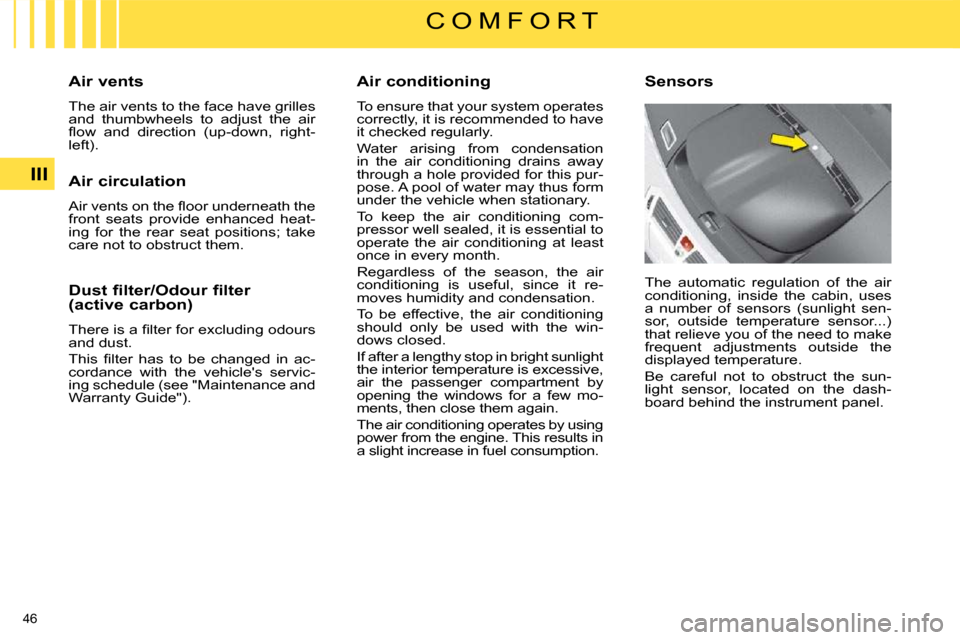
46
III
C O M F O R T
Air conditioning
To ensure that your system operates
correctly, it is recommended to have
it checked regularly.
Water arising from condensation
in the air conditioning drains away
through a hole provided for this pur-
pose. A pool of water may thus form
under the vehicle when stationary.
To keep the air conditioning com-
pressor well sealed, it is essential to
operate the air conditioning at least
once in every month.
Regardless of the season, the air
conditioning is useful, since it re-
moves humidity and condensation.
To be effective, the air conditioning
should only be used with the win-
dows closed.
If after a lengthy stop in bright sunlight
the interior temperature is excessive,
air the passenger compartment by
opening the windows for a few mo-
ments, then close them again.
The air conditioning operates by using
power from the engine. This results in
a slight increase in fuel consumption.
Dust filter/Odour filter
(active carbon)
� �T�h�e�r�e� �i�s� �a� �fi� �l�t�e�r� �f�o�r� �e�x�c�l�u�d�i�n�g� �o�d�o�u�r�s�
and dust.
� �T�h�i�s� �fi� �l�t�e�r� �h�a�s� �t�o� �b�e� �c�h�a�n�g�e�d� �i�n� �a�c�-
cordance with the vehicle's servic-
ing schedule (see "Maintenance and
Warranty Guide").
Air circulation
� �A�i�r� �v�e�n�t�s� �o�n� �t�h�e� �fl� �o�o�r� �u�n�d�e�r�n�e�a�t�h� �t�h�e�
front seats provide enhanced heat-
ing for the rear seat positions; take
care not to obstruct them.
Air vents
The air vents to the face have grilles
and thumbwheels to adjust the air
�fl� �o�w� �a�n�d� �d�i�r�e�c�t�i�o�n� �(�u�p�-�d�o�w�n�,� �r�i�g�h�t�-
left).
The automatic regulation of the air
conditioning, inside the cabin, uses
a number of sensors (sunlight sen-
sor, outside temperature sensor...)
that relieve you of the need to make
frequent adjustments outside the
displayed temperature.
Be careful not to obstruct the sun-
light sensor, located on the dash-
board behind the instrument panel.
Sensors
Page 158 of 337
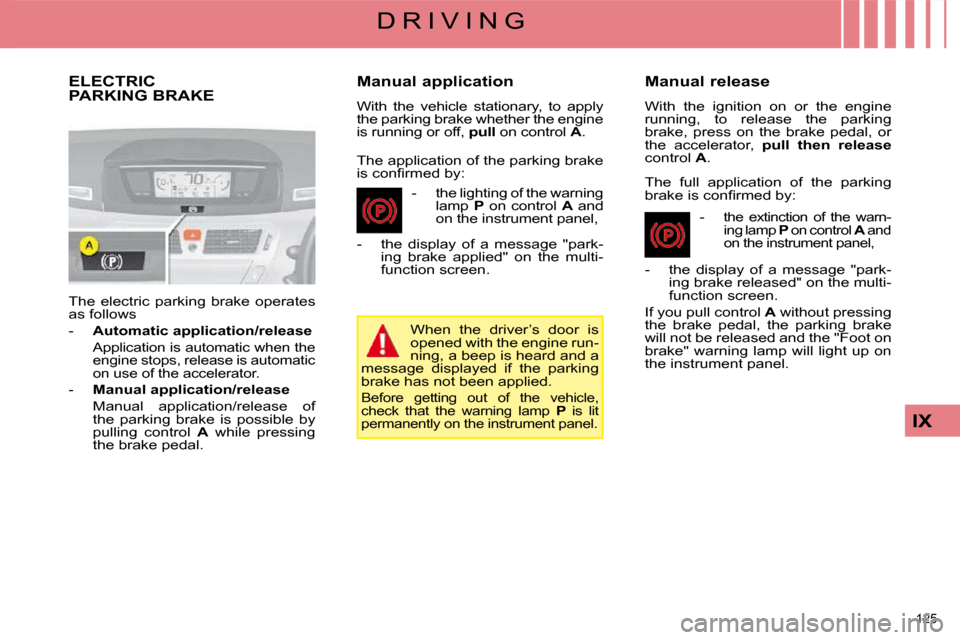
125
IX
D R I V I N G
ELECTRIC PARKING BRAKE
The electric parking brake operates
as follows
- Automatic application/release
Application is automatic when the
engine stops, release is automatic
on use of the accelerator.
- Manual application/release
Manual application/release of the parking brake is possible by
pulling control A while pressing
the brake pedal. Manual application
With the vehicle stationary, to apply
the parking brake whether the engine
is running or off,
pull on control A . Manual release
With the ignition on or the engine
running, to release the parking
brake, press on the brake pedal, or
the accelerator,
pull then release
control A .
-
the extinction of the warn- ing lamp P on control A and
on the instrument panel,
- the display of a message "park- ing brake released" on the multi-
function screen.
If you pull control A without pressing
the brake pedal, the parking brake
will not be released and the "Foot on
brake" warning lamp will light up on
the instrument panel.
The application of the parking brake
�i�s� �c�o�n�fi� �r�m�e�d� �b�y�:�
- the lighting of the warning lamp P on control A and
on the instrument panel,
- the display of a message "park- ing brake applied" on the multi-
function screen.
When the driver’s door is
opened with the engine run-
ning, a beep is heard and a
message displayed if the parking
brake has not been applied.
Before getting out of the vehicle,
check that the warning lamp P is lit
permanently on the instrument panel.
The full application of the parking
�b�r�a�k�e� �i�s� �c�o�n�fi� �r�m�e�d� �b�y�:�
Page 159 of 337
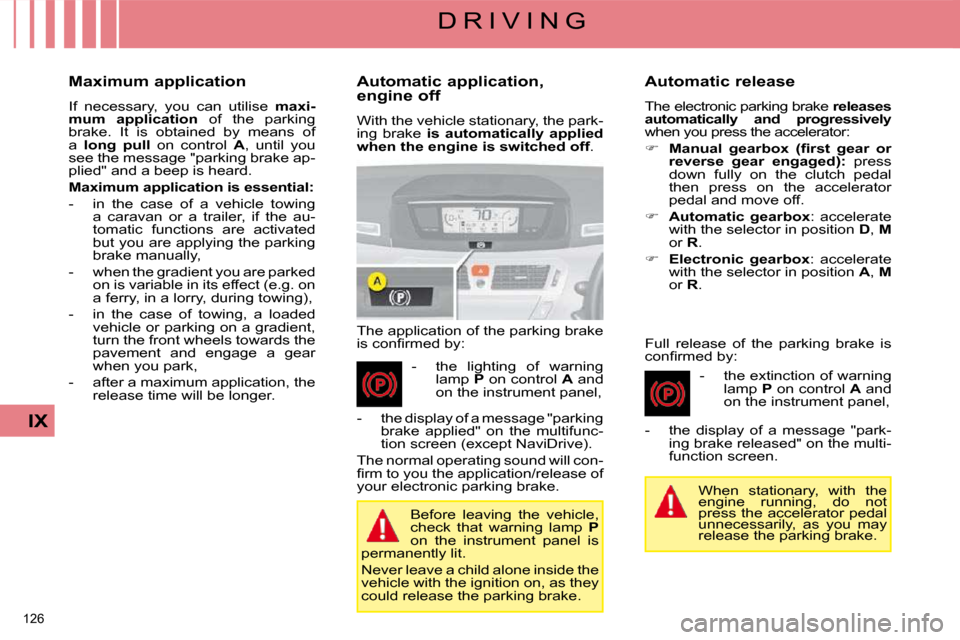
126
IX
D R I V I N G
Automatic application,
engine off
With the vehicle stationary, the park-
ing brake is automatically applied
when the engine is switched off .
The application of the parking brake
�i�s� �c�o�n�fi� �r�m�e�d� �b�y�:� - the lighting of warning lamp P on control A and
on the instrument panel, Automatic release
The electronic parking brake
releases
automatically and progressively
� �w�h�e�n� �y�o�u� �p�r�e�s�s� �t�h�e� �a�c�c�e�l�e�r�a�t�o�r�:�
� Manual gearbox �(�fi� �r�s�t� �g�e�a�r� �o�r�
reverse gear engaged): press
down fully on the clutch pedal
then press on the accelerator
pedal and move off.
� Automatic gearbox � �:� �a�c�c�e�l�e�r�a�t�e�
with the selector in position D , M
or R .
� Electronic gearbox � �:� �a�c�c�e�l�e�r�a�t�e�
with the selector in position A , M
or R .
Full release of the parking brake is
�c�o�n�fi� �r�m�e�d� �b�y�:� - the extinction of warning lamp P on control A and
on the instrument panel,
- the display of a message "park- ing brake released" on the multi-
function screen.
When stationary, with the
engine running, do not
press the accelerator pedal
unnecessarily, as you may
release the parking brake.
Maximum application
If necessary, you can utilise
maxi-
mum application of the parking
brake. It is obtained by means of
a long pull on control A , until you
see the message "parking brake ap-
plied" and a beep is heard.
Maximum application is essential:
- in the case of a vehicle towing a caravan or a trailer, if the au-
tomatic functions are activated
but you are applying the parking
brake manually,
- when the gradient you are parked on is variable in its effect (e.g. on
a ferry, in a lorry, during towing),
- in the case of towing, a loaded vehicle or parking on a gradient,
turn the front wheels towards the
pavement and engage a gear
when you park,
- after a maximum application, the release time will be longer.
Before leaving the vehicle,
check that warning lamp P
on the instrument panel is
permanently lit.
Never leave a child alone inside the
vehicle with the ignition on, as they
could release the parking brake.
- the display of a message "parking
brake applied" on the multifunc-
tion screen (except NaviDrive).
The normal operating sound will con-
�fi� �r�m� �t�o� �y�o�u� �t�h�e� �a�p�p�l�i�c�a�t�i�o�n�/�r�e�l�e�a�s�e� �o�f�
your electronic parking brake.
Page 160 of 337
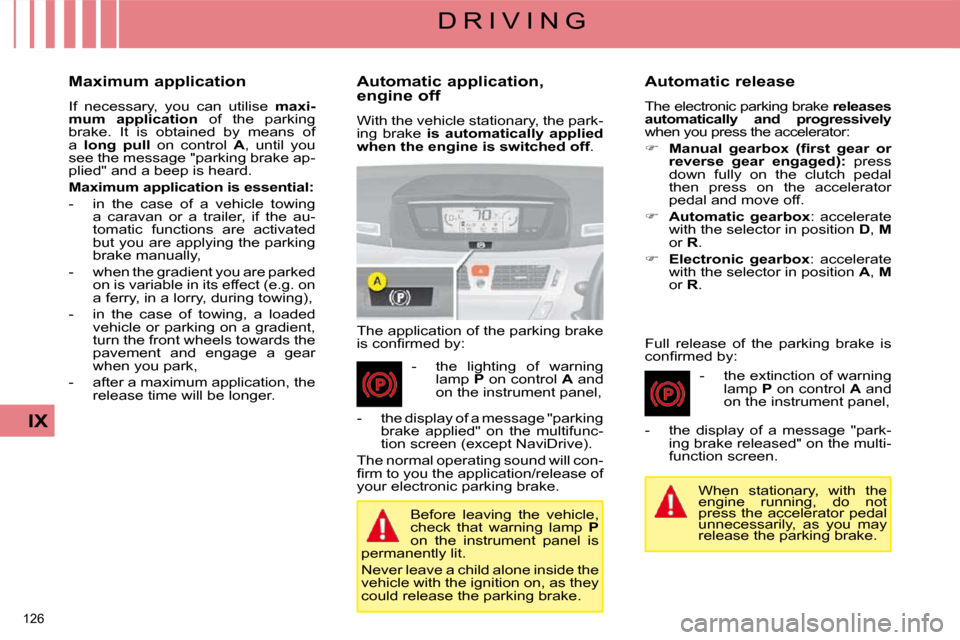
126
IX
D R I V I N G
Automatic application,
engine off
With the vehicle stationary, the park-
ing brake is automatically applied
when the engine is switched off .
The application of the parking brake
�i�s� �c�o�n�fi� �r�m�e�d� �b�y�:� - the lighting of warning lamp P on control A and
on the instrument panel, Automatic release
The electronic parking brake
releases
automatically and progressively
� �w�h�e�n� �y�o�u� �p�r�e�s�s� �t�h�e� �a�c�c�e�l�e�r�a�t�o�r�:�
� Manual gearbox �(�fi� �r�s�t� �g�e�a�r� �o�r�
reverse gear engaged): press
down fully on the clutch pedal
then press on the accelerator
pedal and move off.
� Automatic gearbox � �:� �a�c�c�e�l�e�r�a�t�e�
with the selector in position D , M
or R .
� Electronic gearbox � �:� �a�c�c�e�l�e�r�a�t�e�
with the selector in position A , M
or R .
Full release of the parking brake is
�c�o�n�fi� �r�m�e�d� �b�y�:� - the extinction of warning lamp P on control A and
on the instrument panel,
- the display of a message "park- ing brake released" on the multi-
function screen.
When stationary, with the
engine running, do not
press the accelerator pedal
unnecessarily, as you may
release the parking brake.
Maximum application
If necessary, you can utilise
maxi-
mum application of the parking
brake. It is obtained by means of
a long pull on control A , until you
see the message "parking brake ap-
plied" and a beep is heard.
Maximum application is essential:
- in the case of a vehicle towing a caravan or a trailer, if the au-
tomatic functions are activated
but you are applying the parking
brake manually,
- when the gradient you are parked on is variable in its effect (e.g. on
a ferry, in a lorry, during towing),
- in the case of towing, a loaded vehicle or parking on a gradient,
turn the front wheels towards the
pavement and engage a gear
when you park,
- after a maximum application, the release time will be longer.
Before leaving the vehicle,
check that warning lamp P
on the instrument panel is
permanently lit.
Never leave a child alone inside the
vehicle with the ignition on, as they
could release the parking brake.
- the display of a message "parking
brake applied" on the multifunc-
tion screen (except NaviDrive).
The normal operating sound will con-
�fi� �r�m� �t�o� �y�o�u� �t�h�e� �a�p�p�l�i�c�a�t�i�o�n�/�r�e�l�e�a�s�e� �o�f�
your electronic parking brake.
Page 161 of 337
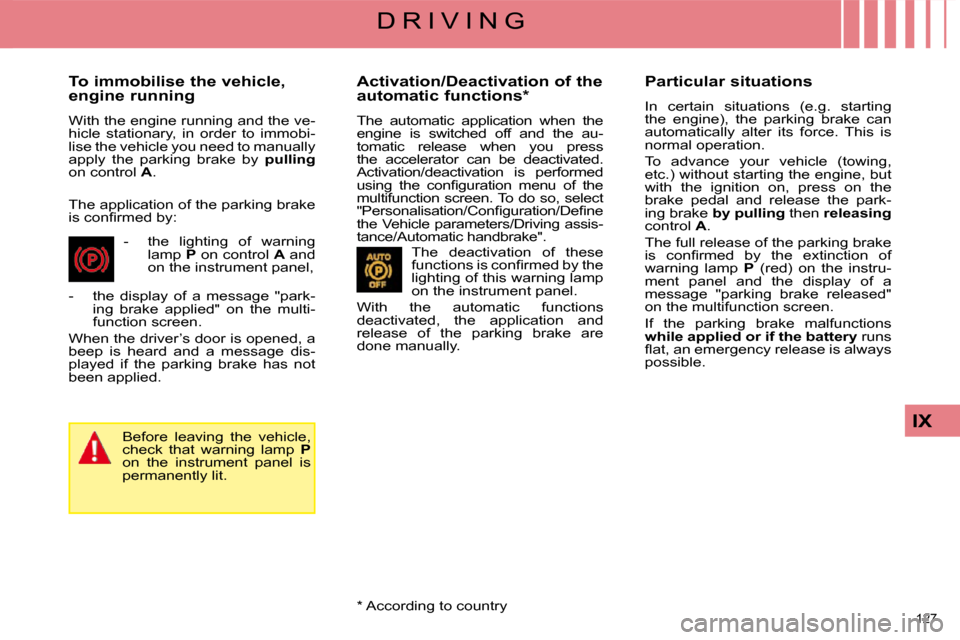
127
IX
D R I V I N G
To immobilise the vehicle,
engine running
With the engine running and the ve-
hicle stationary, in order to immobi-
lise the vehicle you need to manually
apply the parking brake by pulling
on control A .
The application of the parking brake
�i�s� �c�o�n�fi� �r�m�e�d� �b�y�:� - the lighting of warning lamp P on control A and
on the instrument panel,
- the display of a message "park- ing brake applied" on the multi-
function screen.
When the driver’s door is opened, a
beep is heard and a message dis-
played if the parking brake has not
been applied.
Before leaving the vehicle,
check that warning lamp P
on the instrument panel is
permanently lit. Particular situations
In certain situations (e.g. starting
the engine), the parking brake can
automatically alter its force. This is
normal operation.
To advance your vehicle (towing,
etc.) without starting the engine, but
with the ignition on, press on the
brake pedal and release the park-
ing brake
by pulling then releasing
control A .
The full release of the parking brake
�i�s� �c�o�n�fi� �r�m�e�d� �b�y� �t�h�e� �e�x�t�i�n�c�t�i�o�n� �o�f�
warning lamp P (red) on the instru-
ment panel and the display of a
message "parking brake released"
on the multifunction screen.
If the parking brake malfunctions
while applied or if the battery runs
�fl� �a�t�,� �a�n� �e�m�e�r�g�e�n�c�y� �r�e�l�e�a�s�e� �i�s� �a�l�w�a�y�s�
possible.
Activation/Deactivation of the
automatic functions *
The automatic application when the
engine is switched off and the au-
tomatic release when you press
the accelerator can be deactivated.
Activation/deactivation is performed
�u�s�i�n�g� �t�h�e� �c�o�n�fi� �g�u�r�a�t�i�o�n� �m�e�n�u� �o�f� �t�h�e�
multifunction screen. To do so, select
�"�P�e�r�s�o�n�a�l�i�s�a�t�i�o�n�/�C�o�n�fi� �g�u�r�a�t�i�o�n�/�D�e�fi� �n�e�
the Vehicle parameters/Driving assis-
tance/Automatic handbrake".
The deactivation of these
�f�u�n�c�t�i�o�n�s� �i�s� �c�o�n�fi� �r�m�e�d� �b�y� �t�h�e�
lighting of this warning lamp
on the instrument panel.
With the automatic functions
deactivated, the application and
release of the parking brake are
done manually.
* According to country
Page 165 of 337
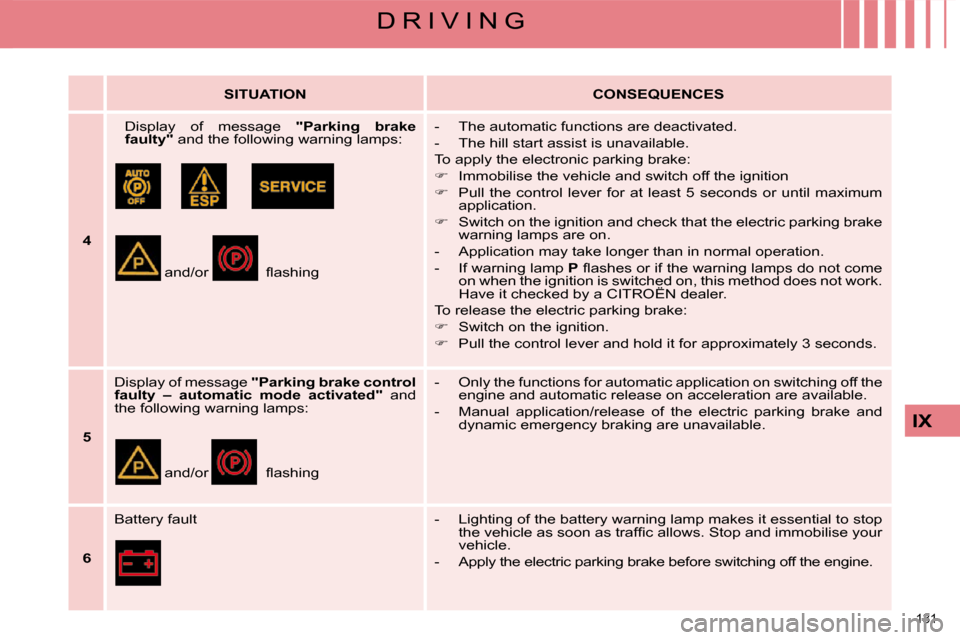
131
IX
D R I V I N G
SITUATION
CONSEQUENCES
4 Display of message
" Parking brake
faulty " � �a�n�d� �t�h�e� �f�o�l�l�o�w�i�n�g� �w�a�r�n�i�n�g� �l�a�m�p�s�:�
and/or
� �fl� �a�s�h�i�n�g� - The automatic functions are deactivated.
- The hill start assist is unavailable.
� �T�o� �a�p�p�l�y� �t�h�e� �e�l�e�c�t�r�o�n�i�c� �p�a�r�k�i�n�g� �b�r�a�k�e�:�
� Immobilise the vehicle and switch off the ignition
� Pull the control lever for at least 5 seconds or until maximum
application.
� Switch on the ignition and check that the electric parking brake
warning lamps are on.
- Application may take longer than in normal operation.
- If warning lamp P� � �fl� �a�s�h�e�s� �o�r� �i�f� �t�h�e� �w�a�r�n�i�n�g� �l�a�m�p�s� �d�o� �n�o�t� �c�o�m�e�
on when the ignition is switched on, this method does not work.
Have it checked by a CITROËN dealer.
� �T�o� �r�e�l�e�a�s�e� �t�h�e� �e�l�e�c�t�r�i�c� �p�a�r�k�i�n�g� �b�r�a�k�e�:�
� Switch on the ignition.
� Pull the control lever and hold it for approximately 3 second s.
5 Display of message
" Parking brake control
faulty – automatic mode activated " and
�t�h�e� �f�o�l�l�o�w�i�n�g� �w�a�r�n�i�n�g� �l�a�m�p�s�:�
and/or
� � �fl� �a�s�h�i�n�g� - Only the functions for automatic application on switchi
ng off the
engine and automatic release on acceleration are available.
- Manual application/release of the electric parking brake a nd
dynamic emergency braking are unavailable.
6 Battery fault - Lighting of the battery warning lamp ma
kes it essential to stop
�t�h�e� �v�e�h�i�c�l�e� �a�s� �s�o�o�n� �a�s� �t�r�a�f�fi� �c� �a�l�l�o�w�s�.� �S�t�o�p� �a�n�d� �i�m�m�o�b�i�l�i�s�e� �y�o�u�r�
vehicle.
- Apply the electric parking brake before switchi ng off the engine.
Page 169 of 337
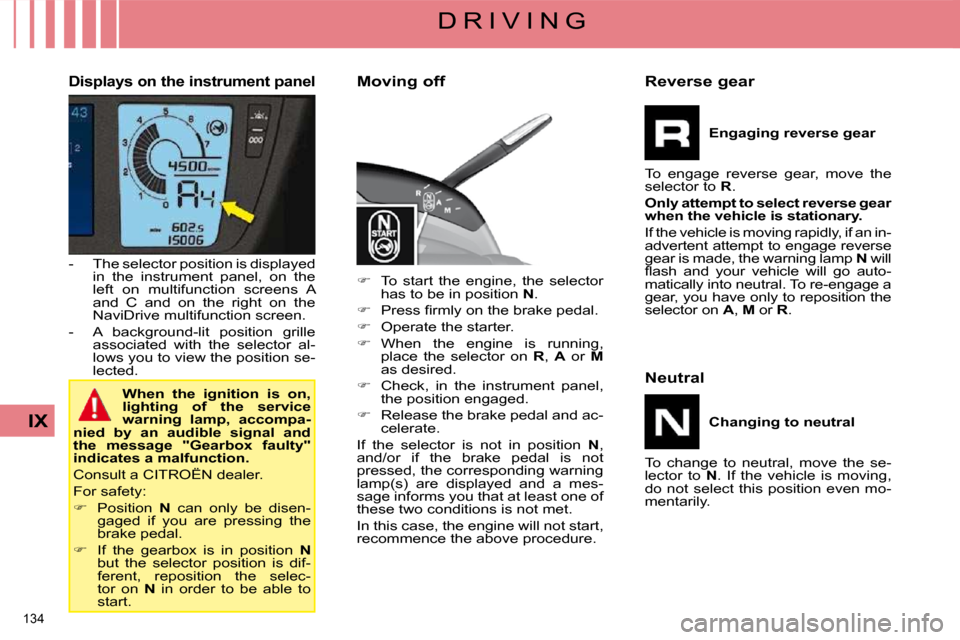
134
IX
D R I V I N G
Displays on the instrument panel
- The selector position is displayed in the instrument panel, on the
left on multifunction screens A
and C and on the right on the
NaviDrive multifunction screen.
- A background-lit position grille associated with the selector al-
lows you to view the position se-
lected.
When the ignition is on,
lighting of the service
warning lamp, accompa-
nied by an audible signal and
the message "Gearbox faulty"
indicates a malfunction.
Consult a CITROËN dealer.
� �F�o�r� �s�a�f�e�t�y�:�
� Position N can only be disen-
gaged if you are pressing the
brake pedal.
� If the gearbox is in position N
but the selector position is dif-
ferent, reposition the selec-
tor on N in order to be able to
start. Moving off
� To start the engine, the selector
has to be in position N .
� � � �P�r�e�s�s� �fi� �r�m�l�y� �o�n� �t�h�e� �b�r�a�k�e� �p�e�d�a�l�.�
� Operate the starter.
� When the engine is running,
place the selector on R , A or M
as desired.
� Check, in the instrument panel,
the position engaged.
� Release the brake pedal and ac-
celerate.
If the selector is not in position N ,
and/or if the brake pedal is not
pressed, the corresponding warning
lamp(s) are displayed and a mes-
sage informs you that at least one of
these two conditions is not met.
In this case, the engine will not start,
recommence the above procedure. Reverse gear
Engaging reverse gear
To engage reverse gear, move the
selector to R .
Only attempt to select reverse gear
when the vehicle is stationary.
If the vehicle is moving rapidly, if an in-
advertent attempt to engage reverse
gear is made, the warning lamp N will
�fl� �a�s�h� �a�n�d� �y�o�u�r� �v�e�h�i�c�l�e� �w�i�l�l� �g�o� �a�u�t�o�-
matically into neutral. To re-engage a
gear, you have only to reposition the
selector on A , M or R .
Neutral
Changing to neutral
To change to neutral, move the se-
lector to N . If the vehicle is moving,
do not select this position even mo-
mentarily.
Page 180 of 337
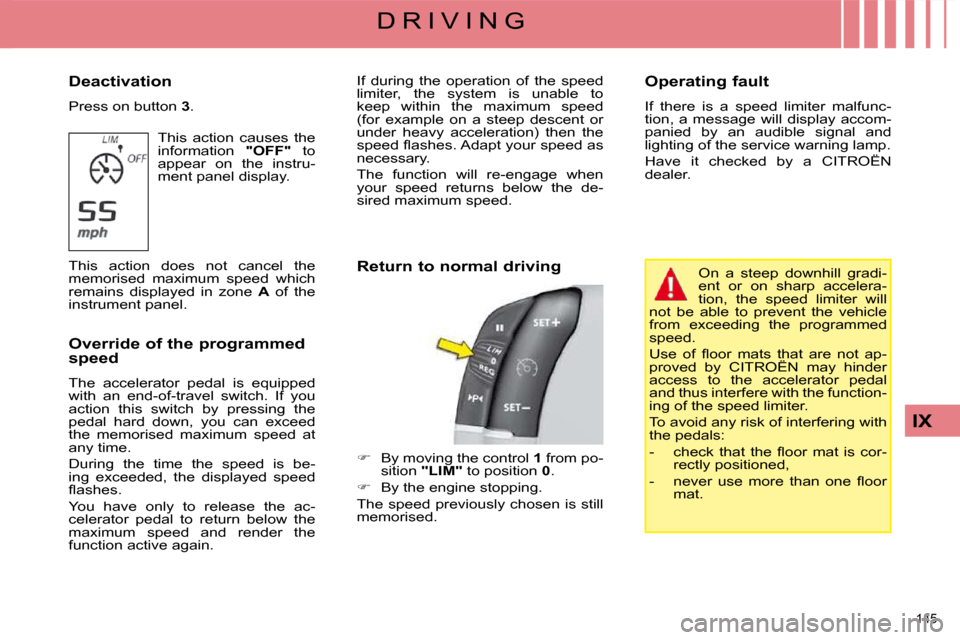
145
IX
D R I V I N G
Deactivation
Press on button 3 .
This action causes the
information "OFF" to
appear on the instru-
ment panel display.
This action does not cancel the
memorised maximum speed which
remains displayed in zone A of the
instrument panel.
Override of the programmed
speed
The accelerator pedal is equipped
with an end-of-travel switch. If you
action this switch by pressing the
pedal hard down, you can exceed
the memorised maximum speed at
any time.
During the time the speed is be-
ing exceeded, the displayed speed
�fl� �a�s�h�e�s�.�
You have only to release the ac-
celerator pedal to return below the
maximum speed and render the
function active again. Return to normal driving
� By moving the control 1 from po-
sition "LIM" to position 0 .
� By the engine stopping.
The speed previously chosen is still
memorised. Operating fault
If there is a speed limiter malfunc-
tion, a message will display accom-
panied by an audible signal and
lighting of the service warning lamp.
Have it checked by a CITROËN
dealer.
If during the operation of the speed
limiter, the system is unable to
keep within the maximum speed
(for example on a steep descent or
under heavy acceleration) then the
�s�p�e�e�d� �fl� �a�s�h�e�s�.� �A�d�a�p�t� �y�o�u�r� �s�p�e�e�d� �a�s�
necessary.
The function will re-engage when
your speed returns below the de-
sired maximum speed.
On a steep downhill gradi-
ent or on sharp accelera-
tion, the speed limiter will
not be able to prevent the vehicle
from exceeding the programmed
speed.
� �U�s�e� �o�f� �fl� �o�o�r� �m�a�t�s� �t�h�a�t� �a�r�e� �n�o�t� �a�p�-
proved by CITROËN may hinder
access to the accelerator pedal
and thus interfere with the function-
ing of the speed limiter.
To avoid any risk of interfering with
�t�h�e� �p�e�d�a�l�s�:�
� � � �-� � �c�h�e�c�k� �t�h�a�t� �t�h�e� �fl� �o�o�r� �m�a�t� �i�s� �c�o�r�- rectly positioned,
� � �-� � �n�e�v�e�r� �u�s�e� �m�o�r�e� �t�h�a�n� �o�n�e� �fl� �o�o�r� mat.